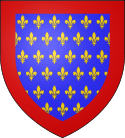Counts and dukes of Valois

The Valois, originally pagus valensis, was a region in the valley of the Oise river in Picardy in the north of France. It was a fief in West Francia and subsequently the Kingdom of France until its counts furnished a line of kings, House of Valois, to succeed the House of Capet in 1328. It was, along with the counties of Beauvais, the Vexin, Vermandois, and Laon, part of the "Oise line" of fiefdom which were held often by one individual or by an individual family as a string of defences against Viking assault on Paris.
The medieval county and duchy of Valois was located in northern France in northeastern Île-de-France. Its capital was Crépy-en-Valois.[1]
Counts of Valois
- Pepin I or Pepin, Count of Vermandois and Valois (ca. 886–892), son of Bernard, King of Italy.
- Pepin II or son of previous, count of Vermandois and Valois.
- Pepin III son of previous, count of Valois.
- Adela daughter of previous, countess of Valois, wife of Waleran II (or Gauthier II), count of Vexin and Amiens.
Waleran, count of the Vexin, died 956, became count of Amiens in right of his wife Adela, married 923
- 956–987 Walter I, also count of the Vexin and Amiens
- 987–1027 Walter II the White, also count of the Vexin and Amiens
- 1027–1035 Drogo, also count of the Vexin and Amiens
- 1035–1063 Walter III, also count of the Vexin, Maine, and Amiens
- 1063–1074 Ralph, also count of the Vexin and Amiens, whose third wife was Anne of Kiev, dowager queen of France (that marriage was childless)
- 1074–1077 Simon, also count of the Vexin and Amiens
To the royal domain in 1076 or 1077.
- Herbert IV (–1080), Count of Vermandois and also count of Valois by marriage with Adela or Alix, daughter of Raoul II count of Vexin and Valois.
- Eudes I the Insane (1080–1085), Count of Vermandois and of Valois, son of previous, he was disinheredited by the council of Barons of France and then he was lord of Saint-Simon by marriage.
- Adelaide sister of previous, countess of Vermandois and Valois, wife of Hugh Magnus.
- Hugh I the Great (1085–1101), Count of Vermandois and of Valois, son of Henry I and Anne of Kiev.
- Raoul I the Valiant (1102–1152), also known as Le Borgne, Count of Vermandois and of Valois, son of previous.
- Hugh II (1152–1160), Count of Vermandois and of Valois, son of Raoul I and Eléonore of Blois.
- Raoul II (1160–1167), Count of Vermandois and of Valois, son of Raoul I and of Petronilla of Aquitaine.
- Philip of Alsace (1167–1185), Count of Flanders (1168–1191), Count of Vermandois and of Valois by marriage
to the royal domain by king Philip II
- Jean-Tristan (1269–1270)
- in royal domain
- Charles I (1284–1325)
- Philip I (1325–1328)
- in royal domain
- Philip II (1344–1375)
- in royal domain
- Louis I (1386?–1406)
Dukes of Valois
- Charles d'Orléans (1406–1465)
- Louis (1465–1498)
- in royal domain
- François (Duke 1498-1515, King of France as Francis I, 1515-1547)
- in royal domain
- Marguerite de Valois (died 1615)
- in royal domain
- Gaston (1626–1660)
- Jean Gaston d'Orléans (1650–1652)
- Philippe de France (1660–1701)
- Philippe Charles d'Orléans (1664–1666)
- Alexandre Louis d'Orléans (1673–1676)
- Philippe d'Orléans (1701–1723)
- Louis d'Orléans (1723–1752)
- Louis Philippe d'Orléans (1752–1785)
- 1773-1785 :Louis Philippe d'Orléans (1773–1850)
- Philippe d'Orléans (1785–1793)
- Louis Philippe d'Orléans (1773–1850)
Notes
- ↑ Mish, Frederick C., Editor in Chief. “Valois.” Webster’s Ninth New Collegiate Dictionary. 9th ed. Springfield, MA: Merriam-Webster Inc., 1985. ISBN 0-87779-508-8, ISBN 0-87779-509-6 (indexed), and ISBN 0-87779-510-X (deluxe).
References
- Anselme, (Père), Histoire généalogique et chronologique de la Maison Royale de France, des pairs, grands officiers de la couronne & de la maison du Roy, 1726.
- Fouquier-Cholet, Eloi, Q.A. Histoire des comtes héréditaires de Vermandois, Saint-Quentin, 1832.
- Mabillon, Jean, Annales ord. Sancti Benedicti. Ticinense. Lucae, 1739.
- Moreri, Louis, Le Grand Dictionnaire Historique, Paris, 1743–1749.
 Chisholm, Hugh, ed. (1911). "Valois, Counts and Dukes of". Encyclopædia Britannica. 27 (11th ed.). Cambridge University Press.
Chisholm, Hugh, ed. (1911). "Valois, Counts and Dukes of". Encyclopædia Britannica. 27 (11th ed.). Cambridge University Press.